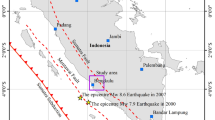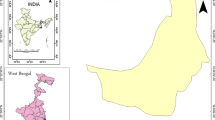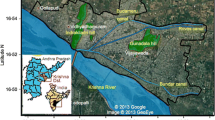Abstract
The seismic response of existing earth dams in Iran is important after an earthquake both to provide emergency supplies and to society as well as to ensure structural safety in engineering terms. Better seismic capacity of earth dam results in less structural damage and reduced impacts following an earthquake disaster. Indirect as well as direct costs following earthquakes have gained much attention from both the engineering and socioec onomic research communities in the last few decades. This study is a valuable tool used to study the response of geotechnical structures to infrequent or extreme events such as earthquakes. The Avaj earthquake (2002, Iran) was applied to a series of model tests which was conducted to study the response of soil profiles under seismic loading. The acceleration records at different locations within the soil bed and at its surface along with the settlement records at the surface were used to analyze the soil seismic response. A combination of several software packages with a generated visual user interface computer code by authors named as “Abbas Converter” were employed to evaluate the variation of shear modulus and dam** ratio with shear strain amplitude to assess their effects on site response. The proposed method was applied to the Korzan earth dam of Hamedan province in Iran. Site response analysis using the measured shear wave velocity, estimated modulus reduction, and dam** ratio as input parameters produced good agreement with the computed site response in this study.












Similar content being viewed by others
References
Abbaszadeh Shahri A, Esfandiyari B, Hamzeloo H (2009) Evaluation of a nonlinear seismic geotechnical site response analysis method subjected to earthquake vibrations (case study: Kerman province, Iran). Arab J Geosci (in press)
Alkhatib M (1994) Liquefaction assessment by strain energy approach. Ph.D. thesis (T. Kagawa, advisor), Wayne State University. p 212
Berrill JB, Davis RO (1985) Energy dissipation and seismic liquefaction of sands: revised model. Soils Found 25(2):106–118
Blake TF (1997) Formula (4). In: Youd TL and Idriss IM (eds) Summary Report of proceedings of the NCEER workshop on evaluation of liquefaction resistance of soils. Technical report. NCEER 97-0022
Borcherdt RD, Wentworth CM, Janssen A et al. (1991). Methodology for predictive GIS map** for special study zones for strong ground shaking in the San Francisco Bay Region. In: Proceedings of the fourth international conference on seismic zonation, 3. pp 545–552
Byrne MP, SeidKarbasi M (2003) Seismic stability of impoundments. In: 17th Annual Symposium, Vancouver Geotechnical Society
Davis RO, Berrill JB (1982) Energy dissipation and seismic liquefaction in sands. Earthquake Eng Struct Dyn 10:59–68
Dobry R, Ladd RS, Yokel RM et al. (1982) Prediction of pore water pressure buildup and liquefaction of sands during earthquakes by the cyclic strain method. NBS Building Science Series 138, US Department of Commerce. p 152
Fear CE, McRoberts EC (1995) Report on liquefaction potential and catalogue of case record. Internal research report. Geotechnical Engineering Library, Department of Civil Engineering, University of Alberta, Edmonton, Alberta, Canada, p 338
Finn WDL (1988) Dynamic analysis in geotechnical engineering. In: Proceedings, earthquake engineering and soil dynamics II—recent advances in ground motion evaluations. Geotechnical special publication 20, ASCE. pp 523–591
Finn WDL (1993) Evaluation of liquefaction potential. In: Proceedings of the conference on soil dynamics and geotechnical earthquake engineering, Balkema, Rotterdam, 1993
Golesorkhi R (1989) Factors influencing the computational determination of earthquake-induced shear stresses in sandy soils. Dissertation submitted in partial satisfaction of the requirements for the degree of Doctor of Philosophy, University of California at Berkeley
Hardin BO, Drnevich VP (1972) Shear modulus and dam** in soil: design equations and curves. J Soil Mech Found Eng Div ASCE 98(7):667–692
Idriss IM (1997) Evaluation of liquefaction potential and consequences: historical perspective and updated procedures. Presentation notes, 3rd short course on evaluation and mitigation of earthquake induced liquefaction hazards, San Francisco, March 13–14. p 16
Joyner WB, Fumal T (1984) Use of measured shear-wave velocity for predicting geological site effect on strong motion. In: Proceedings of eighth world conference on earthquake engineering, 2. pp 777–783
Kayen RE, Mitchell JK (1997) Assessment of liquefaction potential during earthquakes by arias intensity. J Geotech Geoenviron Eng 123(12):1162–1174
Lanzo G, Vucetic M, Doroudian M (1997) Reduction of shear modulus at small strains in simple shear. J Geotech Geoenviron Eng ASCE 123(11):1035–1042
Law KT, Cao YL, He GN (1990) An energy approach for assessing seismic liquefaction potential. Can Geotech J 27(3):320–329
Lee MKW, Finn WDL (1991) DESRA-2C: dynamic effective stress response analysis of soil deposits with energy transmitting boundary including assessment of liquefaction potential. The University of British Columbia, Faculty of Applied Science, Vancouver
Liang L (1995) Development of an energy method for evaluating the liquefaction potential of soil deposit. Ph.D. dissertation (J.L. Figueroa and A.S. Saada, advisors), Case Western Reverse University. p 281
Liao SSC, Whitman RV (1986) Catalogue of liquefaction and non-liquefaction occurrences during earthquakes. Research report, Department of Civil Engineering, Massachusetts Institute of Technology, Cambridge
Liao SSC, Veneziano D, Whitman RV (1988) Regression models for evaluating liquefaction probability. J Geotech Eng 114(4):389–411
Malagnini L, Rovelli A, Hough SE, Seeber L (1993) Site amplification estimates in the Garigliano Valley, Central Italy, based on dense array measurements of ambient noise. Bull Seismol Soc Am 83:1744–1755
Medvedev J (1962) Engineering Seismology. Academia Nauk Press, Moscow, 260
Milana G, Barba S, Del Pezzo E, Zambonelli E (1996) Site response from ambient noise measurements: new perspectives from an array study in Central Italy. Bull Seismol Soc Am 86:320–328
Moroto N, Tanoue Y (1989) Liquefaction potential of sandy ground from an energy consideration. In: Proceeding of 4th international conference on soil dynamics and earthquake engineering, Computational Mechanics Publications, South Hampton, UK. pp 22–25
Mostaghel M, Habibaghi K (1978) Cyclic liquefaction strength of sands. Report, School of Engineering, Pahlavi University, Shiraz, Iran. p 25
Mostaghel M, Habibaghi K (1979) Cyclic liquefaction strength of sands. Earthquake Eng Struct Dyn 7:213–233
Nguyen F, Van Rompaey G, Teerlynck H, Van Camp M, Jongmans D, Camelbeeck T (2004) Use of microtremor measurement for assessing site effects in Northern Belgiuminterpretation of the observed intensity during theMs = 5.0 June 11 1938 earthquake. J Seismol 8:41–56
Ostadan F, Deng N, Arango I (1996) Energy-based method for liquefaction potential evaluation, phase1—feasibility study. U.S. Department of Commerce, Technology Administration, National Institute of Standards and Technology, Building and fire Research Laboratory
Ostadan F, Deng N, Arango I (1998) Energy-based method for liquefaction potential evaluation. In: Proceeding: eleventh European conference on earthquake engineering, Sept. pp 6–11
Robertson PK, Campanella RG (1985) Liquefaction of sands using the CPT. J Geotech Eng Division ASCE 111(GT3):384–403
Robertson PK, Woeller DJ, Finn WDL (1992) Seismic cone penetration test for evaluating liquefaction potential under cyclic loading. Can Geotech J 29(4):686–695
Seed HB (1979) Soil liquefaction and cyclic mobility evaluation for level ground during earthquakes. J Geotech Eng Div ASCE 105(GT2):201–255
Seed HB, Booker JR (1977) Stabilization of potentially liquefiable sand deposits. J Geotech Eng Div ASCE 103(GT7):757–768
Seed HB, De Alba P (1986) Use of SPT and CPT test for evaluating the liquefaction resistance of soils. In: Proceedings in situ 1986, ASCE
Seed RB, Harder LF (1990) SPT-based analysis of cyclic pore pressure generation and undrained residual strength. In: Proceedings of the H.B. Seed Memorial Symposium, 2. Bi-Tech Publishing Ltd., Berkeley. pp 351–376
Seed HB, Idriss IM (1971) Simplified procedure for evaluating soil liquefaction potential. J Soil Mech Found Div ASCE 97(SM9):1249–1273
Seed, H.B. and Idriss, I.M., (1982). Ground motions and soil liquefaction during earthquakes. Earthquake Engineering Research Institute, Oakland, California, Monograph Series, 134
Seed HB, Arango I, Idriss IM (1983) Evaluation of liquefaction potential using field performance data. J Geotech Eng Div ASCE 109(3):458–482
Seed HB, Tokimatsu K, Harder LF, Chung RM (1985) Influence of SPT procedures in soil liquefaction resistance evaluations. J Geotech Eng Division ASCE 111(12):1425–1445
Seed HB, Wong RT, Idriss IM, Tokimatsu K (1986) Moduli and dam** factors for dynamic analyses of cohesionless soils. J Geotech Eng 112(GT11):1016–1032
Shibata T, Teparaksa V (1988) Evaluation of liquefaction potentials of soils using cone penetration tests. Soil Found 28(2):49–60
Strak TD, Olsen SM (1995) Liquefaction resistance using CPT and field case histories. J Geotech Eng 121(12):856–869
Tiers GR, Seed HB (1968) Cyclic stress–strain characteristics of clay. J Soil Mech Found Eng Div ASCE 94(2):555–569
Tokimatsu K, Yoshimi Y (1983) Empirical correlation ship of soil liquefaction based on NSPT value and fines content. Soil Found JSSMFE 23(4):56–74
Tokimatsu K, Taya Y and Kubota Y (1995) Correlation between CPT data and dynamic properties of in situ frozen samples. In: Proceedings, third international conference on recent advances in geotechnical earthquake engineering and soil dynamics, vol. I, St. Louis, Missouri, August
Trifunac MD (1995) Empirical criteria for liquefaction in sands via standard penetration tests and seismic wave energy. Soil Dyn Earthquake Eng 14:419–426
USGS (2002). Available at: http://www.usgs.gov
Vucetic M, Dobry R (1991) Effect of soil plasticity on cyclic response. J Geotech Eng ASCE 117(1):89–107
Whitman RV (1971) Resistance of soil to liquefaction and settlement. Soils Found 11(4):59–68
Author information
Authors and Affiliations
Corresponding author
Rights and permissions
About this article
Cite this article
Abbaszadeh Shahri, A., Behzadafshar, K. & Rajablou, R. Verification of a new method for evaluation of liquefaction potential analysis. Arab J Geosci 6, 881–892 (2013). https://doi.org/10.1007/s12517-011-0348-x
Received:
Accepted:
Published:
Issue Date:
DOI: https://doi.org/10.1007/s12517-011-0348-x




